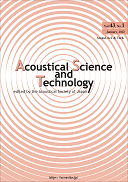
- Issue 6 Pages 297-
- Issue 5 Pages 241-
- Issue 4 Pages 219-
- Issue 3 Pages 177-
- Issue 2 Pages 87-
- Issue 1 Pages 1-
- |<
- <
- 1
- >
- >|
-
Souta Yoshida, Risako Tanigawa, Kohei Yatabe, Yasuhiro Oikawa2022Volume 43Issue 3 Pages 177-187
Published: May 01, 2022
Released on J-STAGE: May 01, 2022
JOURNAL FREE ACCESSIn this paper, we propose applying a high-speed polarization interferometer to underwater sound fields for their non-invasive visualization and temperature measurement. Underwater sound is usually measured by hydrophones that may disturb the sound field. To circumvent such disturbance, for airborne sound, a high-speed polarization interferometer has been proposed as a new measurement method. It enables non-contact measurement of non-stationary sound fields in air. This research applies the high-speed interferometer to underwater sound and confirms its capability of visualization. As an application, we also propose a non-invasive temperature measurement method that calculates temperature from the sound speed of visualized sound. As a result, we confirmed that the proposed method can measure the water temperature with an accuracy of about ±0.5 to 1.5°C.
View full abstractDownload PDF (2169K) -
Katuhiro Maki, Ken-Ichi Sakakibara, Kimiko Yamakawa, Shigeaki Amano2022Volume 43Issue 3 Pages 188-196
Published: May 01, 2022
Released on J-STAGE: May 01, 2022
JOURNAL FREE ACCESSTo identify effective communication methods for rescuing victims buried in an avalanche, we investigate the acoustic transfer characteristics by simulating a snow avalanche to identify a method for effectively communicating with buried individuals. The results indicate that sound attenuation at a depth of 30 cm from the snow surface is 60 dB over a wide frequency range when the sound is emitted above the surface. Because the sound insulation of the simulated snow avalanche is extremely high, the sound emitted from the surface will likely not reach the buried victims. However, vibrations due to foot stomping on the surface of snow are likely to be transmitted to a buried individual as sound.
View full abstractDownload PDF (834K)
-
Shigeaki Amano, Kimiko Yamakawa, Mariko Kondo2022Volume 43Issue 3 Pages 197-200
Published: May 01, 2022
Released on J-STAGE: May 01, 2022
JOURNAL FREE ACCESSA previous study showed that a discriminant model using variables of the rise and steady+decay durations of frication could successfully classify the fricative /s/ and affricate /ts/ pronounced at a normal speaking rate. To examine the model's general ability regarding speaking rates, it was examined with /s/ and /ts/ at various speaking rates. The model was able to classify the consonants at both fast and slow speaking rates with almost the same error ratio at the normal speaking rate. However, it could not classify the consonants when the data of all speaking rates were combined. These results suggest that the discriminant model can capture the homologous structure of /s/ and /ts/ at each speaking rate but that it requires revision to classify /s/ and /ts/ across a wide range of speaking rates.
View full abstractDownload PDF (391K)
-
Liu JieYing, Toru Kamekawa, Atsushi Marui2022Volume 43Issue 3 Pages 201-204
Published: May 01, 2022
Released on J-STAGE: May 01, 2022
JOURNAL FREE ACCESSDownload PDF (432K) -
Hiroshi Kashiwazaki, Takahiro Iwami, Akira Omoto2022Volume 43Issue 3 Pages 205-208
Published: May 01, 2022
Released on J-STAGE: May 01, 2022
JOURNAL FREE ACCESSDownload PDF (543K) -
Hideki Kawahara, Kohei Yatabe2022Volume 43Issue 3 Pages 209-212
Published: May 01, 2022
Released on J-STAGE: May 01, 2022
JOURNAL FREE ACCESSDownload PDF (1373K) -
Tsubasa Sakai, Daisuke Morikawa, Parham Mokhtari2022Volume 43Issue 3 Pages 213-215
Published: May 01, 2022
Released on J-STAGE: May 01, 2022
JOURNAL FREE ACCESSDownload PDF (620K)
- |<
- <
- 1
- >
- >|